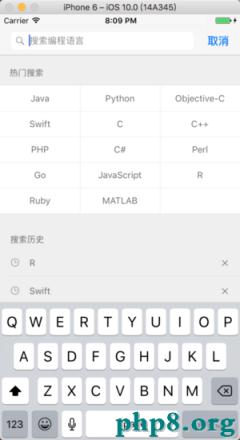iOS開發——播放系統音效、自定義音效
需求大致分為三種:
1.震動
2.系統音效(無需提供音頻文件)
3.自定義音效(需提供音頻文件)
我的工具類的封裝:
[cpp]
//
// WQPlaySound.h
// WQSound
//
// Created by 念茜 on 12-7-20.
// Copyright (c) 2012年 __MyCompanyName__. All rights reserved.
//
#import <UIKit/UIKit.h>
#import <AudioToolbox/AudioToolbox.h>
@interface WQPlaySound : NSObject
{
SystemSoundID soundID;
}
/**
* @brief 為播放震動效果初始化
*
* @return self
*/
-(id)initForPlayingVibrate;
/**
* @brief 為播放系統音效初始化(無需提供音頻文件)
*
* @param resourceName 系統音效名稱
* @param type 系統音效類型
*
* @return self
*/
-(id)initForPlayingSystemSoundEffectWith:(NSString *)resourceName ofType:(NSString *)type;
/**
* @brief 為播放特定的音頻文件初始化(需提供音頻文件)
*
* @param filename 音頻文件名(加在工程中)
*
* @return self
*/
-(id)initForPlayingSoundEffectWith:(NSString *)filename;
/**
* @brief 播放音效
*/
-(void)play;
@end
[cpp]
//
// WQPlaySound.m
// WQSound
//
// Created by 念茜 on 12-7-20.
// Copyright (c) 2012年 __MyCompanyName__. All rights reserved.
//
#import "WQPlaySound.h"
@implementation WQPlaySound
-(id)initForPlayingVibrate
{
self = [super init];
if (self) {
soundID = kSystemSoundID_Vibrate;
}
return self;
}
-(id)initForPlayingSystemSoundEffectWith:(NSString *)resourceName ofType:(NSString *)type
{
self = [super init];
if (self) {
NSString *path = [[NSBundle bundleWithIdentifier:@"com.apple.UIKit"] pathForResource:resourceName ofType:type];
if (path) {
SystemSoundID theSoundID;
OSStatus error = AudioServicesCreateSystemSoundID((__bridge CFURLRef)[NSURL fileURLWithPath:path], &theSoundID);
if (error == kAudioServicesNoError) {
soundID = theSoundID;
}else {
NSLog(@"Failed to create sound ");
}
}
}
return self;
}
-(id)initForPlayingSoundEffectWith:(NSString *)filename
{
self = [super init];
if (self) {
NSURL *fileURL = [[NSBundle mainBundle] URLForResource:filename withExtension:nil];
if (fileURL != nil)
{
SystemSoundID theSoundID;
OSStatus error = AudioServicesCreateSystemSoundID((__bridge CFURLRef)fileURL, &theSoundID);
if (error == kAudioServicesNoError){
soundID = theSoundID;
}else {
NSLog(@"Failed to create sound ");
}
}
}
return self;
}
-(void)play
{
AudioServicesPlaySystemSound(soundID);
}
-(void)dealloc
{
AudioServicesDisposeSystemSoundID(soundID);
}
@end
調用方法步驟:
1.加入AudioToolbox.framework到工程中
2.調用WQPlaySound工具類
2.1震動
[cpp]
WQPlaySound *sound = [[WQPlaySound alloc]initForPlayingVibrate];
[sound play];
2.2系統音效,以Tock為例
[cpp]
WQPlaySound *sound = [[WQPlaySound alloc]initForPlayingSystemSoundEffectWith:@"Tock" ofType:@"aiff"];
[sound play];
2.3自定義音效,將tap.aif音頻文件加入到工程
[cpp]
WQPlaySound *sound = [[WQPlaySound alloc]initForPlayingSoundEffectWith:@"tap.aif"];
[sound play];




